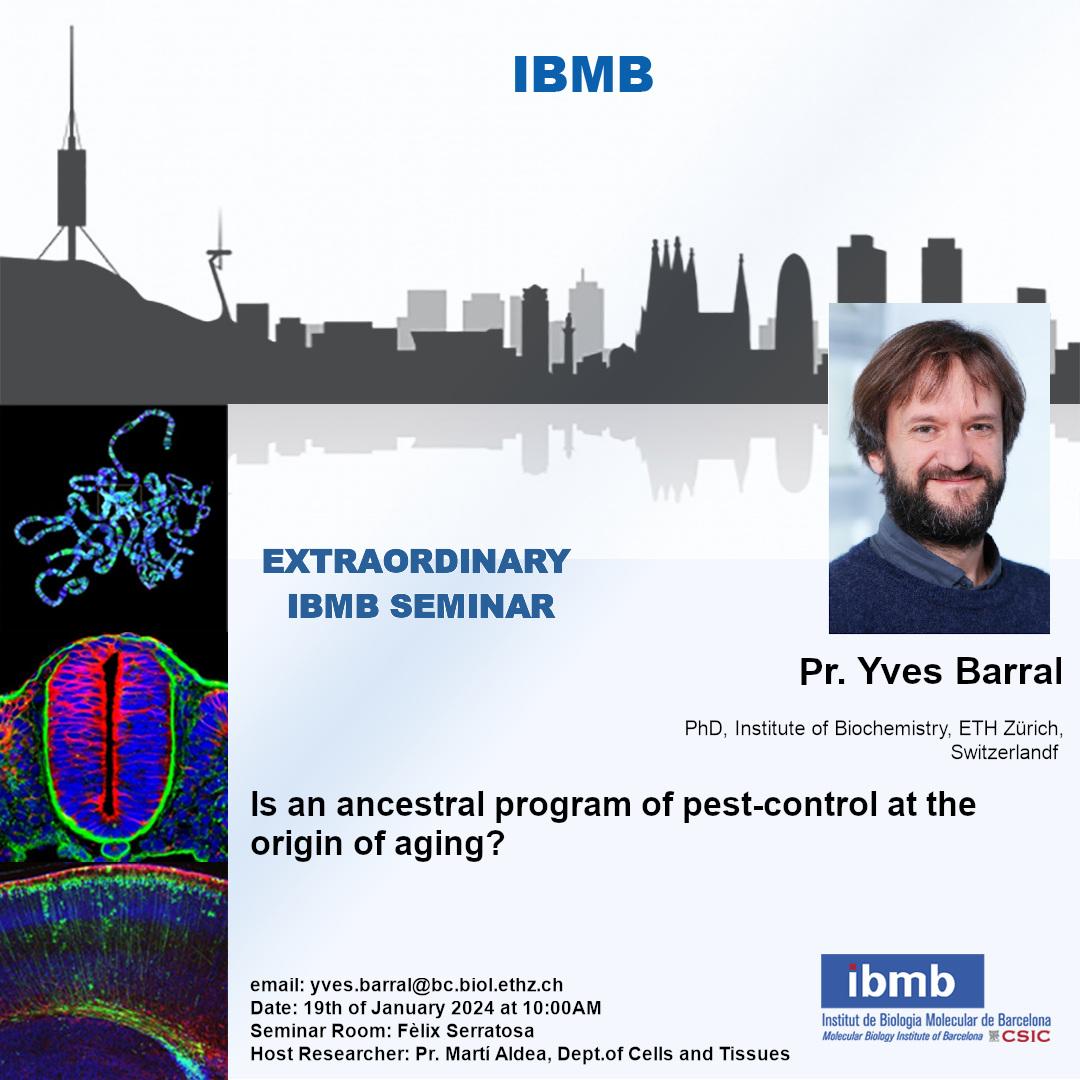Date: Friday, April 12th | Felix Serratosa room | 12|04|2024 Time: 10:00 AM Speaker: Valerio Di Domenico Guerin…
EXTRAORDINARY IBMB SEMINAR, Friday, January 19th 10:00 AM | Pr. YVES BARRAL
Date: Friday, January 19th | Serratosa | 19|01|2024
Time: 10:00 AM
Speaker: Pr. Yves Barral
PhD,
Institute of Biochemistry, ETH Zürich, Switzerland
Title: “Is an ancestral program of pest-control at the origin of aging?“
Seminar Room: Serratosa
Host researcher: Pr. Martí Aldea
Email: yves.barral@bc.biol.ethz.ch
Keywords: Aging, Nuclear Pore Complexes (NPCs), Introns, Native Immunity, Mechanisms of Senescence
Abstract:
At the cellular level, aging is manifested by the decline of many aspects of cellular organization and physiology, such as the accumulation of misfolded proteins and P-bodies, the fragmentation of mitochondria, the decrease of their membrane potential, an increase in lysosomal pH, genome instability, chromosome loss and the alteration of nuclear shape and organization. However, whether and how these different phenotypes are connected to each other and what this might tell us about cellular organization or the origins of the aging process have remained unclear. Using budding yeast as a model to study the mechanisms of replicative aging, we recently established that remodeling of nuclear pore complexes (NPCs), whereby NPCs become stripped of their nuclear basket, is a key event in yeast aging and possibly in many other organisms. Here, I will present our most recent progress in the attempt to understand the relevance of NPC remodeling in aging and discuss the possibility that this event may actually coordinate and link many, if not all phenotypes of aging. Indeed, basket-less NPCs acted in a dominant manner to trigger phenotypes as diverse as P-body formation, senescence entry and chromosome loss. Strikingly, in all these cases stripped NPCs did so by promoting the leakage of pre-mRNAs out of the nucleus. Remarkably, while this caused the down-regulation of most intron containing transcripts, the resulting liberation of spliceosome capacity also enhanced the splicing efficiency of few dedicated transcripts, leading to the up-regulation of their expression.
Aging phenotypes resulted from the combined action of these two effects. Thus, our data suggest the existence of a selected, intron- and NPC-dependent program for the global regulation of gene expression and that this program turns into a death program with age. I will discuss the biological relevance and evolutionary consequences of this observation, its probable conservation in metazoans, and the possibility that it offers a unifying model for the emergence and coordination of aging processes. Finally, I will develop the notion that this ancestral pathway originally evolved to limit the propagation of intracellular pathogens.
Biosketch:
Yves Barral, born of French parents in Mexico grew up in Lyon and studied in Lyon, Paris, Seattle, Nice and Tübingen before defending his PhD (1994) on cell cycle control at the Université Pierre et Marie Curie (Now part of Sorbonne Université) in Paris. After training in Cell Biology with Michael Snyder at Yale (1995-1999), he has been Assistant Professor of Biochemistry at the ETH Zurich since August 1999 and Associate Professor since October 2005. He was promoted to Full Professor in 2009.
At the ETH Yves Barral and his coworkers (https://bc.biol.ethz.ch/research/barral.html) investigate the mechanisms and functional relevance of asymmetric cell division using budding yeast as model system. These studies have brought him to become interested in processes as diverse as microtubule function, aging, the storage of cellular memory and innate immunity.


